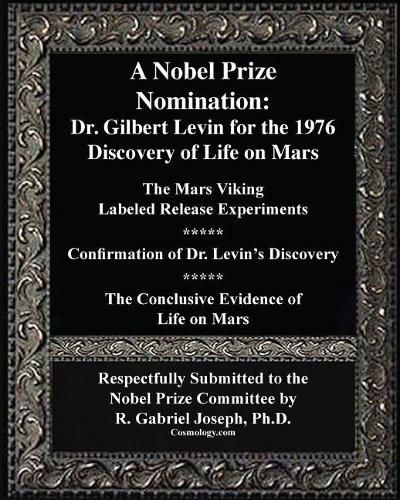Readings Newsletter
Become a Readings Member to make your shopping experience even easier.
Sign in or sign up for free!
You’re not far away from qualifying for FREE standard shipping within Australia
You’ve qualified for FREE standard shipping within Australia
The cart is loading…






In 1976, NASA stated that the Mars Viking life detection experiments might be perhaps the most important experiment in the history of science. Dr. Levin’s Viking Labeled Release (LR) experiment, one of three included on Viking, was designed to detect biological activity on Mars (1-4). In the course of developing the Viking Labeled Release (LR) experiment, and prior to transport to Mars, thousands of laboratory and field tests were performed and the LR experiment proved capable of detecting a very wide range of microorganisms including bacteria, algae and fungi. The Viking LR experiment was elegant and straight-forward. It took a sample of Martian soil and added a nutrient containing radioactive carbon. The presence of radioactivity in the gasses released was evidence of active metabolism. A control experiment treated a second sample that had been heat-treated to kill microorganisms. In every experiment conducted, the control (heat treated) sample yielded negative results whereas positive results were obtained from the raw sample, including evidence of biological reproduction. Both Viking landing sites, some 4,000 miles apart, produced strong responses and met the pre-mission criteria for the detection of biological activity, and life on Mars (1-4). Dr. Levin’s Mars Viking LR data are supported by evidence of (A) waxing and waning and increasing and decreasing concentrations of methane at a variety of localities both at ground level and in the atmosphere of Mars (5-9), the most logical source of which is biological activity; (B) biochemical analyses and detection of biological residue in meteors ejected from Mars (10-15); © simulation studies demonstrating various organisms can survive and flourish in a Mars-like environment (16-20); (D) Martian structures and specimens with features resembling stromatolites (21-24) –the likely remnants of cyanobacteria/blue-green algae; (E) visual observation of greenish substances which change in size and appear to be algae (23-25); and (F) the expert judgment of 40 experts in fungi, algae and lichens and 30 experts in geomorphology and mineralogy, who after closely examining photos of Martian specimens taken by NASA’s Rover’s Curiosity and Opportunity, formed a statistically significant consensus that these were living organisms resembling terrestrial mushrooms and other species of fungi (26-27). Indeed, many of these experts referred to the visual evidence as obvious (26).
$9.00 standard shipping within Australia
FREE standard shipping within Australia for orders over $100.00
Express & International shipping calculated at checkout
In 1976, NASA stated that the Mars Viking life detection experiments might be perhaps the most important experiment in the history of science. Dr. Levin’s Viking Labeled Release (LR) experiment, one of three included on Viking, was designed to detect biological activity on Mars (1-4). In the course of developing the Viking Labeled Release (LR) experiment, and prior to transport to Mars, thousands of laboratory and field tests were performed and the LR experiment proved capable of detecting a very wide range of microorganisms including bacteria, algae and fungi. The Viking LR experiment was elegant and straight-forward. It took a sample of Martian soil and added a nutrient containing radioactive carbon. The presence of radioactivity in the gasses released was evidence of active metabolism. A control experiment treated a second sample that had been heat-treated to kill microorganisms. In every experiment conducted, the control (heat treated) sample yielded negative results whereas positive results were obtained from the raw sample, including evidence of biological reproduction. Both Viking landing sites, some 4,000 miles apart, produced strong responses and met the pre-mission criteria for the detection of biological activity, and life on Mars (1-4). Dr. Levin’s Mars Viking LR data are supported by evidence of (A) waxing and waning and increasing and decreasing concentrations of methane at a variety of localities both at ground level and in the atmosphere of Mars (5-9), the most logical source of which is biological activity; (B) biochemical analyses and detection of biological residue in meteors ejected from Mars (10-15); © simulation studies demonstrating various organisms can survive and flourish in a Mars-like environment (16-20); (D) Martian structures and specimens with features resembling stromatolites (21-24) –the likely remnants of cyanobacteria/blue-green algae; (E) visual observation of greenish substances which change in size and appear to be algae (23-25); and (F) the expert judgment of 40 experts in fungi, algae and lichens and 30 experts in geomorphology and mineralogy, who after closely examining photos of Martian specimens taken by NASA’s Rover’s Curiosity and Opportunity, formed a statistically significant consensus that these were living organisms resembling terrestrial mushrooms and other species of fungi (26-27). Indeed, many of these experts referred to the visual evidence as obvious (26).